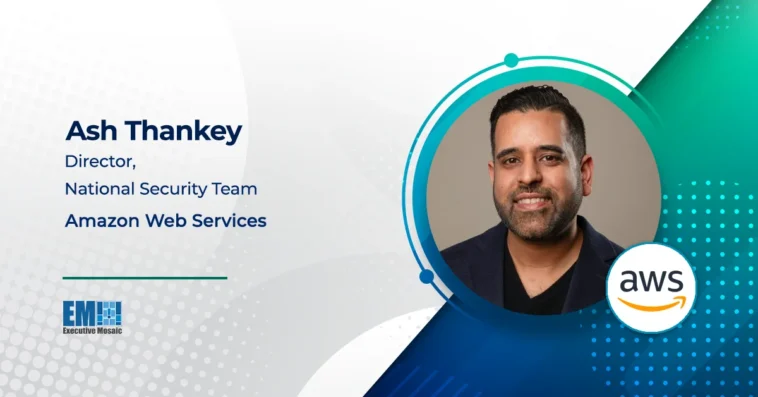In his role as director of the U.S. national security team for Amazon Web Services, Ash Thankey fosters a close relationship between AWS and the intelligence community. Thankey sat down with Executive Mosaic recently to discuss some of the trends, emerging technologies, threats and opportunities shaping the defense and intelligence landscapes today.
Read below for Thankey’s Executive Spotlight interview.
What’s your outlook on the global defense landscape? What significant changes or trends are you seeing, and how are those factors moving the GovCon market?
The global defense landscape is changing quickly. As it shifts, we’re focused on how this evolution manifests in the race for leadership in domains such as space, cybersecurity, biotech and emerging technologies. Space continues to be a growing domain as satellites and other technologies become more advanced and play even more important roles both in national security and in the functioning of our everyday lives. Cybersecurity is also top of mind across the public sector and industry, and AWS is constantly growing our capabilities to anticipate and exceed the needs of our customers to secure and protect critical infrastructure. And of course, key emerging technologies such as artificial intelligence and quantum are being explored and developed by the U.S., its allies and its adversaries.
What do you think are the most pressing national security threats we’re facing today? How is AWS addressing these threats?
Our top priorities include deterrence and ensuring the U.S. and its allies have superior capabilities that are leaps ahead of adversaries. Resiliency and emerging capabilities are key to deterrence, and AWS is focused on bolstering terrestrial and space-based resiliency, protecting our infrastructure and sharing the lessons we’ve learned over the years to strengthen and secure the global supply chain.
Of course, emerging technologies present some of our biggest opportunities, but also our biggest challenges. AWS is helping to explore open-source intelligence and information sharing with coalition partners — for example, using AI and machine learning for things like sentiment analysis. We’re also using generative AI to enable red teaming and simulate attack scenarios, pinpoint weaknesses and plan preventative measures. We’re bolstering Graphics Processing Units, or GPUs, across our regions and bringing in leading partners and their capabilities to complement native AWS offerings. And we’re pressing forth on developing quantum and quantum key distribution technology to ensure we’re at the forefront of development in this area.
What is the top challenge you’re seeing as federal agencies migrate to the cloud? What solution would you propose to this problem?
Knowledge development and learning across key stakeholders are critical to cloud migration. Cloud capabilities can fundamentally transform how the intelligence enterprise delivers its missions, but stakeholders must be aligned and set clear direction for their agencies. At AWS, we are committed to helping agencies address this challenge and expanding the availability of cloud training.
Additionally, mission owners must build an understanding of how to bring more innovation into their capabilities. Cloud services can help them cover down on undifferentiated support so that they can focus their resources on differentiated mission capability. Reevaluating how contracting officers measure mission delivery and how budget officers establish flexibility between CapEx and OpEx can help further fuel innovation. We also see opportunities to modernize the way cloud and cloud capabilities are accredited to include authority to operate (ATO) reciprocity, which would increase speed to mission and reduce barriers that keep innovative independent software vendors out of the classified space. These changes require a mindset shift that embraces the opportunities technology offers to encourage innovation and transform mission delivery. AWS is proud to be a partner in these efforts.





